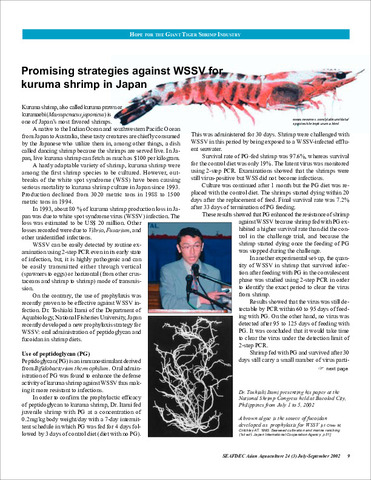Towards Ensuring the Safety and Viability of Seafood: the Regional Guidelines on Cold Chain Management of Fish and Fishery Products in the ASEAN Region
Share
นามธรรม
Seafood is a perishable commodity that undergoes several chemical and biological changes immediately after capture or harvest. With inadequate temperature control protocols along the supply chain, the quality, and safety of the seafood could deteriorate. Adoption of proper cold chain management and monitoring at every stage of the supply chain is critical in order to extend the shelf-life of seafood and ensure its freshness, safety and economic value. In conformity to the need to ensure the safety and quality of fish and fishery products, the ASEAN-SEAFDEC Member Countries adopted in 2011, the Resolution and Plan of Action on Sustainable Fisheries for Food Security for the ASEAN Region Towards 2020 that includes provisions calling for the ASEAN And SEAFDEC to: “Optimize the utilization of catch from water to market by reducing post-harvest losses and waste to increase fish supply and improve economic returns through promotion of appropriate technologies and facilities along the supply chain” (Resolution No. 20), and specifically, “Introduce and provide support for the development and application of technologies that optimize the utilization of catches, reduce post-harvest losses, wastes and discards in commercial and small-scale fisheries and processing operations, through improved processing, facilities and infrastructure development, on-board and on-shore handling, storage, distribution and marketing if fish and fishery products” (Plan of Action No. 58), and “Promote and conduct training programs and develop training materials to upgrade the technical skills and competencies of personnel in the public and private sectors on fisheries post-harvest technology and food safety management system” (Plan of Action No. 63).
In responding to such call, the Government of Singapore allocated funds for the implementation of a project aimed at creating a platform for the ASEAN Member States (AMSs) to share knowledge, experiences, and cost-effective technologies on cold chain management of seafood, and developing generic guidelines on cold chain management for fish and fishery products to serve as benchmark for the AMSs in developing their respective national guidelines. Implemented by the former Postharvest Technology Centre of the Agri-Food and Veterinary Authority of Singapore (now the Marine Aquaculture Centre of the Singapore Food Agency) as the SEAFDEC Collaborating Centre for the programmes of the SEAFDEC Marine Fisheries Research Department (MFRD), the project on Cold Chain Management for Seafood involved assessment and pilot trials of cold chain management in the AMSs and consultation workshops, the results of which had been used to develop the generic guidelines on cold chain management.
การอ้างอิง
Yihang, O. (2020). Towards Ensuring the Safety and Viability of Seafood: the Regional Guidelines on Cold Chain Management of Fish and Fishery Products in the ASEAN Region. Fish for the People , 18(2), 29-31. http://hdl.handle.net/20.500.12066/6560
เรื่อง
คอลเลกชัน
รายการที่เกี่ยวข้อง
แสดงรายการที่เกี่ยวข้องตามชื่อผู้แต่งผู้สร้างและเรื่อง
-
Genetic identification of all four mangrove mud crab species (genus Scylla) using multiple molecular markers
Mandal, Anup; Mani, Anjali Kottayil; Lamech, Ruban; Anandajothi, Elamaran; Venkatachalam, Shanmuga Arasu; Dinakaran, Gajendiran K.; Quinitio, Emilia T.; Kandan, Shanmuganathan (Springer, 2021-02-05)Misleading identification and subsequent publications on biological, molecular, and aquaculture data of mangrove mud crab (genus Scylla de Hann 1833) is a major concern in many countries. In this study, multiple molecular ... -
Changes in mRNA expression of grouper (Epinephelus coioides) growth hormone and insulin-like growth factor I in response to nutritional status
Pedroso, Fiona L.; De Jesus-Ayson, Evelyn Grace T.; Cortado, Hanna H.; Hyodo, Susumu; Ayson, Felix G. (Elsevier, 2006)Growth hormone (GH) and insulin-like growth factor-I (IGF-I) are key links to nutritional condition and growth regulation in teleost. To understand the endocrine mechanism of growth regulation in grouper, we cloned the ... -
Promising strategies against WSSV for kuruma shrimp in Japan
Itami, Toshiaki (Aquaculture Department, Southeast Asian Fisheries Development Center, 2002)





